| Designation: | AMX-10P |
 |
|---|---|---|
| Manufacturer: | Nexter | |
| Product type: | Armoured Vehicles | |
| Name: | Infantry fighting vehicle |
The Nexter Systems (previously Giat Industries) AMX-10P ICV was developed from 1965 by the Atelier de Construction d'Issy-les-Moulineaux to meet a French Army requirement for a vehicle to replace the older AMX VCI based on the chassis of the AMX-13 light tank. The first prototypes of the AMX-10P were completed in 1968.
Production began at the Atelier de Construction Roanne in 1972 and first vehicles were delivered to the 7th Mechanised Brigade at Rheims in 1973.
In 1990, Singapore awarded the company a contract for 22 AMX-10 PAC 90 Fire Support Vehicles and 22 AMX-10P vehicles with 25 mm one-person Dragar turrets. These have now been delivered and were all in the special Marines configuration, which is detailed in a separate entry.
Production of the AMX-10P was completed early in 1994 after about 1,810 had been built for the home and export markets.
Nexter Systems is no longer marketing the AMX-10P infantry combat vehicle.
In 2008 the French Army still has a large fleet of AMX-10P ICVs and these operate with the Nexter Systems Leclerc MBT.
In the longer term the full-tracked AMX-10P ICV will be replaced by the new 8 × 8 Nexter Systems VBCI (Vehicule Blindé de Combat d'Infanterie). A total of 700 vehicles are to be delivered in two versions.
These are 550 in the Vehicule Blindé de Combat d'Infanterie (ICV) and 150 in the Véhicule Poste de Commandement (command post) configuration. The first batch of 20 vehicles will be delivered in mid-2008. This will comprise 15 ICV and five CPV.
For this reason, a decision has been taken to upgrade at least part of the French Army fleet of AMX-10P and additional details of this are given later in this entry.
The hull of the AMX-10P is made of all-welded aluminium armour with the driver's compartment at the front of the vehicle on the left, engine compartment to his right and the troop compartment at the rear of the hull. The driver has a single-piece hatch cover that opens to the rear, in front of which are three day periscopes, the centre one of which can be replaced by a passive periscope for driving at night.
The engine compartment is provided with a fire extinguishing system and the complete power pack can be replaced in two hours. The air inlet and outlet louvres are in the top of the hull and the exhaust outlet is in the right side of the hull. The transmission consists of a torque converter with an electromagnetically operated clutch and a steer/drive unit comprising a gearbox, a steering mechanism and a Power Take Off (PTO) for the water-jets.
The two-man Toucan II turret is mounted in the centre of the vehicle, offset slightly to the left of the centreline, with the gunner seated on the left and the commander on the right. Both the commander and the gunner have a single-piece hatch cover that opens either side of their positions. The commander has an M371 day sight with a magnification of ×1 and ×6, a direct sight for anti-aircraft use and an external sight for direct fire. The gunner has an OB-40 day/night periscope, which has a day magnification of ×6 (10° field of view) and a night magnification of ×5 (7° field of view). The vehicle could also be delivered with the gunner's OB-40 sight replaced by an M406 day sight with a magnification of ×2 and ×6, which is replaceable with an OB-37 image intensification sight with a magnification of ×6. The commander and gunner also have seven day periscopes for all-round observation.
The Nexter Systems M693 20 mm dual-feed cannon is mounted externally on the turret and has a dual-feed system allowing the gunner to select either HE or AP projectiles, and a burst selector. The cyclic rate of fire of the 20 mm cannon is 700 rds/min and the maximum effective range is 1,500 m. Of 325 rounds of 20 mm ready ammunition carried in the turret, 260 are HE and 65 AP.
Mounted coaxially above and to the right of the 20 mm M693 cannon is a 7.62 mm machine gun, which has a cyclic rate of fire of 900 rds/min and a maximum effective range of 1,000 m. Of 900 rounds of ammunition for the machine gun carried in the turret, 200 are for ready use. Mounted coaxially with the 20 mm cannon and 7.62 mm machine gun is a PH 9A searchlight and mounted on either side of the forward part of the turret are two electrically operated 80 mm smoke grenade dischargers.
The eight infantrymen are seated on individual bucket seats in the troop compartment at the rear. One man is seated forward and right of the turret facing the rear, one man to the right of the turret facing the turret, four men to the rear of the turret (two each side facing outwards), and one man on each side at the rear facing inwards. They enter and leave by the large electrically operated ramp at the rear, which is hinged at the bottom and has two doors, each with a firing port. Over the top of the troop compartment are two roof hatches, which are hinged in the centre and can be locked vertical. Seven day periscopes are fitted in the roof of the troop compartment, one at the front on the right, two in either side and two at the rear. The basic AMX-10P is also in service carrying two Euromissile MILAN launchers with 10 missiles carried in the hull. If required, the 2,000 m range Euromissile MILAN launchers can be mounted on the sides of the hull top, one each side.
The torsion bar suspension either side consists of five single rubber-tyred road wheels with the drive sprocket at the front, idler at the rear and three track-return rollers. The first and fifth road wheel stations are fitted with hydraulic shock-absorbers. The tracks have replaceable rubber pads.
The AMX-10P is fully amphibious and propelled in the water by two water-jets at the rear of the hull, one either side of the ramp. Before entering the water two bilge pumps are switched on (one in the engine compartment and one in the troop compartment) and the trim vane is erected at the front of the hull. When not in use the trim vane is stowed on the glacis plate. The AMX-10P was marketed without the amphibious capability.
Standard equipment includes an NBC system, in the right side of the hull, and a heater. The vehicle can be delivered without the NBC system or the heater and optional equipment includes an NBC detector and decontamination equipment.
The prototype of the AMX-10P 25 was shown for the first time in June 1983. It is based on the standard AMX-10P hull without the original two-man turret. The commander now sits to the left of the turret and has a single-piece hatch cover that opens to the front, five day periscopes and a day/night periscope.
Mounted in the centre of the hull roof is the Nexter Systems Dragar one-man turret armed with a Nexter Systems 25 mm Model 811 dual-feed cannon which has 175 rounds of HE and 45 rounds of armour-piercing ammunition for ready use. A 7.62 mm machine gun is mounted coaxial to the 25 mm cannon on the right side of the turret and has 200 rounds of ready use ammunition.
The AMX-10P 25 ICV has been developed by Nexter Systems as a private venture and has so far been ordered by Singapore in the special amphibious version.
The Turkish Army has now taken delivery of a quantity of Nexter Systems Dragar turrets armed with a stabilised 25 mm cannon for some of its locally built AIFVs.
Full details of the AMX-10P Marines, developed specifically for the use of marines, are given in a separate entry. This is only used by Indonesia and Singapore.
This model is unarmed and is fitted with a fixed commander's cupola with three forward-facing vision blocks. It has a crew of three: the driver and two orderlies. The vehicle can carry three stretcher patients or one stretcher and four seated patients. The AMX-10 ambulance has an air conditioning system, a searchlight, washing facilities, an oxygen system and blood transfusion equipment.
This is the basic vehicle with its turret removed and replaced by an observation position for the instructor and drivers not under instruction.
This has the Toucan I one-man turret or TOP 7 cupola, and a crew of five consisting of the commander/chief mechanic, three mechanics and the driver. On the right side of the roof at the rear is a crane with a capacity of 6,000 kg. When it is being used, two jacks are positioned under the rear of the hull between the ground and the floor of the vehicle. The AMX-10 ECH is used to carry out power pack changes on other members of the AMX-10P family as well as changing torsion bars on both the AMX-10P and the AMX-30. The latter has now been replaced in French Army service by the Leclerc MBT.
This is the basic AMX-10P, with the Toucan II turret replaced by a new two-man Lancelot turret based on the TH 20, with four ready to launch 4,000 m range Euromissile HOT missiles and a further 14 missiles carried in the rear of the hull. The crew of five consists of the commander and gunner in the turret, two missile loaders and the driver. The turret has powered traverse through 360° at a speed of 50°/s and manual traverse at a speed of 10°/s. The missiles can be elevated from -12 to +18° at a speed of 18°/s (powered) and 22°/s (manual). The missiles are launched by the gunner who is seated on the left side of the turret and has an M509 sight with a magnification of ×3 and ×12, while the commander operates the M427 laser range-finder, which has a maximum range of 8,000 m and a magnification of ×8 (day), and ×3.5 (night). In addition, the turret has six day periscopes and two vision blocks. The AMX-10 HOT has a combat weight of 14,100 kg and an unloaded weight of 12,400 kg. This model has been produced for export, the only known user being Saudi Arabia. As an option the turret could be fitted with a Castor thermal camera with two magnifications.
This is the command member of the AMX-10P family and is identical to the basic vehicle except that it has additional communications equipment and a crew of six (two officers, one NCO, two radio operators and the driver). Mounted on the top of the hull at the rear is a portable generator, which is positioned on the ground when the vehicle is being used in the static role. When two AMX-10 PCs are back-to-back, a canopy can be erected between them, and in addition an awning can be erected at the side of the hull. This model is in service with the French and several other armies.
This has no turret and is fitted with a roof-mounted RATAC (Radar For Field Artillery Fire) pulse Doppler radar scanner. The vehicle has a crew of five: commander; radar operator; assistant radar operator; radio operator; driver. The radar has four operating modes: ground surveillance; acquisition and identification; angular deviation measurement; automatic tracking. The radar is in the forward part of the vehicle on the right side, with the radar operating console behind it and the plotting table at the rear on the right. Height including radar is 2.84 m. This model also has a navigation system and an identification system. At least 24 of this version have been sold to Saudi Arabia.
This 6 × 6 reconnaissance vehicle armed with a turret-mounted 105 mm gun uses many automotive components of the AMX-10P series. Full details of the AMX-10RC are given in a separate entry. Production of this has been completed and it is now no longer being marketed by Nexter Systems.
The AMX-10 SAO is used for battlefield observation and artillery fire control and is an AMX-10P with its Toucan II turret replaced by a new two-man turret armed with an externally mounted 7.62 mm machine gun on the right side. Mounted on the top of the turret are four electrically operated 80 mm smoke grenade dischargers firing forwards. Turret traverse is electric, two-speed, with a maximum speed of 50°/s. The turret has a laser range-finder with a maximum range of 8,000 m coupled to a day sight with a magnification of ×8 and a night sight with a magnification of ×4.5. It also has a binocular telescope with a magnification of ×2.5 and ×10, which has adjustable cross wires, a retractable sun filter and can be elevated from -10 to +45°. The crew of five consists of the commander (who normally operates the binocular telescope), the second in command (usually the laser range-finder operator), two radio operators and a driver. The AMX-10 SAO is fitted with a vehicle attitude corrector which enables it to establish its exact position. The ATILA system message transmitter unit (CMS) can be used in the SAO vehicle.
This is based on the AMX-10 PC command vehicle but has been modified internally to carry a gyrostabilised theodolite, a topographic survey theodolite, distance measuring equipment and a navigation system.
This model tows a 120 mm TDA Model MO-120-RT-61 rifled mortar, as well as carrying 60 rounds of ammunition, of which 56 are stored horizontally and four vertically. The AMX-10 TM has a crew of six consisting of commander, aimer, artificer, loader, ammunition carrier and driver, and is fitted with a Toucan I turret armed with a 20 mm cannon and a 7.62 mm machine gun, which have elevations of +50° and depressions of -8°, turret traverse being a full 360°. The turret is manually operated: maximum traverse speed is 12°/s and maximum elevation speed 16°/s. The turret has an optical sight with magnifications of ×1 and ×6, plus periscopes. The AMX-10 TM has been produced in quantity for both the home and export markets.
This is based on the AMX-10PC command vehicle chassis and has been designed for use by artillery observers. Its crew of four consists of a commander, observer, radio operator and driver. The turret, which is manned by one or two men, is provided with equipment for day and night observation and local defence. The equipment fitted in the turret enables the acquisition of target co-ordinates and the manual or automatic transmission of artillery messages. Armament consists of a 7.62 mm machine gun and four smoke grenade dischargers. The onboard laser range-finder has a magnification of ×8 and can be dismounted if required. The turret optical sight has magnifications of ×2.5 and ×10, a thermal camera and periscopes.
Two versions of the AMX-10P have been developed to mount parts of the ATILA automatic artillery fire-control system. The AMX-10 VFA is used at regimental and battery level and the AMX-10 VLA, which does not have a computer, is used as an artillery liaison vehicle.
This is also known as the AMX-10PC SAF and is used with the ATILA artillery fire-control system. It has a crew of five consisting of the radio operator, driver, two warrant officers and one commanding officer. It is fitted with an auxiliary power unit in the forward part of the vehicle, two air conditioning systems for the electronics and crew, a multipurpose computer, a data processing equipment centre, a man/machine interface (screen/keyboard) and three radio sets.
The AMX-10 PAC 90 was developed primarily for the export market and was first announced in 1978. It basically consists of an AMX-10P ICV hull fitted with the Nexter Systems TS 90 90 mm two-person turret which is also mounted on the Panhard ERC 90 F4 Sagaie (6 × 6) armoured car as well as the Renault VBC 90 (6 × 6) armoured car. The Indonesian Marine models have automotive characteristics and modifications similar to the AMX-10P Marines described in a separate entry. More recently this version has also been adopted by Singapore, which also adopted the Marines version of the AMX-10P with the 25 mm Nexter Systems Dragar one-man turret.
The primary role of the AMX-10 PAC 90 is that of anti-tank and fire support on the battlefield at ranges between 1,000 and 2,500 m, but it can also be used as a reconnaissance vehicle or as an APC, as well as transporting 2,000 m range Euromissile MILAN anti-tank or 81 mm mortar teams.
The Nexter Systems 90 mm gun fires the following types of ammunition: canister, high-explosive, high-explosive long-range, HEAT, smoke and APFSDS.
There are 20 rounds of ammunition, 12 HEAT and 8 HE, carried in the turret, 16 in the turret bustle to the rear of the commander, who also loads the gun, and four behind the commander's seat. Another 10 rounds are carried in the hull. A 7.62 mm machine gun is mounted coaxially to the left of the main armament, for which 2,000 rounds of ammunition are carried in the turret, with an additional 1,200 rounds carried in the hull. Mounted either side of the turret towards the rear are two 80 mm smoke grenade dischargers.
The four infantrymen sit on individual seats at the rear of the hull and enter and leave by the large ramp in the hull rear, which has two doors, each with a firing port. There are four day periscopes in the rear roof of the troop compartment, one in each side and two at the rear.
The French Delegation Generale pour l'Armement (DGA) requested that Nexter Systems submit a detailed proposal on areas in which the AMX-10P could be upgraded to extend its operational life until sufficient numbers of the new VBCI are in service.
Late in 2005, following extensive trials with a prototype upgraded AMX-10P IFV, the DGA awarded the company a contract worth over EUR50 million for the upgrade of 108 AMX-10P ICVs of the French Army.
Nexter Systems main armoured fighting vehicle production and integration centre at Roanne will provide the kits, with the actual work being carried out in the French Army units.
Deliveries are scheduled to take place from 2006 through to 2008, sufficient vehicles for about two regiments and will help maintain capability until the new generation of wheeled IFV are delivered to the French Army.
The AMX-10P ICV upgrade includes the installation of a new passive armour package to the front, sides, rear and hull top to provide an enhanced level of survivability. Other enhancements include a modified rear power-operated ramp, new torsion bars and reinforced transmission.
The current AMX-10P ICV is fully amphibious, propelled in the water by two waterjets mounted one either side of the hull at the rear. These and the trim vane installed at the front of the hull will be removed to save weight but the vehicle will retain its fording capability.
A number of other enhancements to the AMX-10P ICV were also proposed by the company but these were not adopted. These could have included the Galix armoured vehicle protection system that can fire a variety of grenades, improved sighting for the 20 mm cannon and a more powerful diesel engine.
As well as the basic AMX-10P ICV, the French Army operates a wide range of variants, including 120 mm mortar towing vehicles, command post, ambulance and artillery fire control/forward observation vehicles. These are not expected to be upgraded at this stage.
|
||||||||||||||||||||||||||||||||||||||||||||||
|
|||||||||||||||
|
|||||||||||||||||||||||||||||||||
Related Articles |
|
Infantry Fighting Vehicle (29.01.2007) |
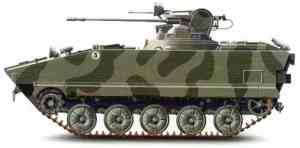 |
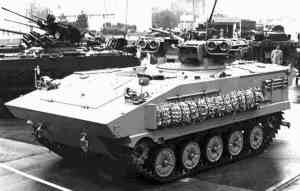 |
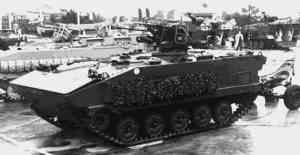 |
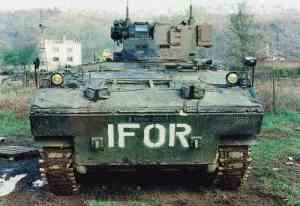 |
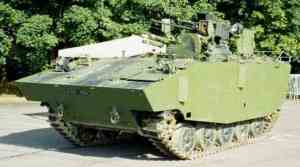 |
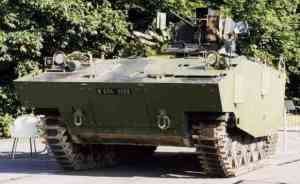 |
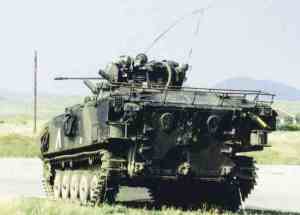 |
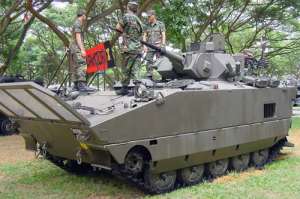 |







